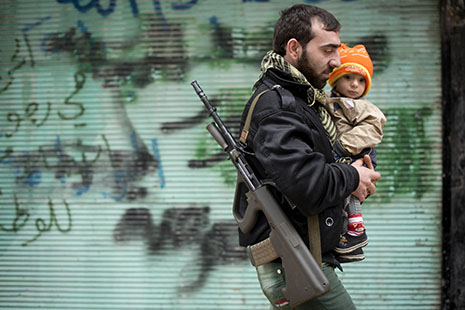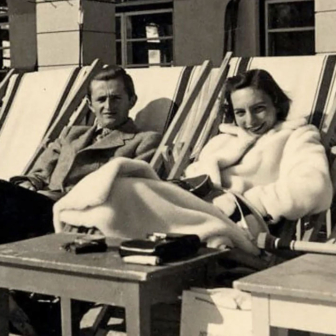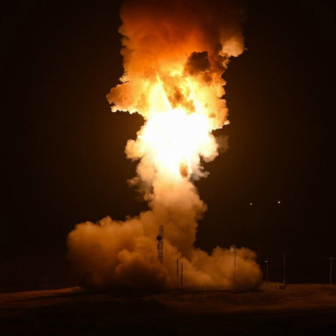NEGOTIATIONS for an agreement to limit the proliferation of conventional weapons – which range from handguns and rifles to fighter jets and battle tanks – will come to life once again on 18–24 March. Australia, long a proponent of the proposed Arms Trade Treaty, will again throw its weight behind the process. Not for the first time, hopes are high for a resolution. Despite considerable goodwill, the treaty process stalled on the final day of the previous round of negotiations in July last year. Although many people blamed the timing of the talks and last-minute nerves, there were deeper dynamics at work.
Under the UN Charter, there is nothing inherently illegal about conventional weapons, although they can become illegal under certain circumstances – when particular weapons, such as anti-personnel landmines and cluster munitions, are banned, for example, or when a specific end user is subject to an arms embargo. But this doesn’t mean the trade in arms is transparent. Even if details of the weapon, system or platform are made public, price and cost are often opaque, especially as weapons transfers can include elements such as gifting, offsets and barter deals. As a confidence-building measure, all United Nations member states have been invited to make public their arms transfers (including, since 2006, small arms and light weapons) via the United Nations Register of Conventional Arms, yet over the past decade fewer than half have regularly done so.
What the Arms Trade Treaty seeks to do is to modify government transfers of both large and small weapons. It will encourage states to restrain transfers for strategic reasons – to avoid fuelling arms races, for example – but also wants governments to recognise humanitarian factors and prevent sales that might contribute to abuses, atrocities, intra-state conflict and the persistence of poverty.
The renewed talks come after what turned out to be a big year for conventional arms control, 2012, which followed a big year for conventional wars. No credible observer of these phenomena argues that weapons cause wars, but it is generally agreed that the availability of weapons contributes to the outbreak, intensity and duration of conflict. Nowhere was this demonstrated more graphically than in Libya and Syria, where war broke out in 2011. Both conflicts highlighted several dynamics of conventional arms transfers and controls: they drew attention to the misuse of conventional weapons by government forces; they highlighted where such large amounts of weapons came from; and they showed how non-state forces procure weapons to fight against state forces. At the start of 2013, with weapons from Libya fuelling the conflict in northern Mali and the Syrian conflict continuing, efforts to understand the nexus between the availability of weapons and the mechanics of control are as timely as they will ever be.
At present, UN member states are under no obligation to exercise restraint in exporting weapons. Indeed, there are only a handful of mechanisms constraining conventional arms. They include the voluntary UN Register, the politically binding United Nations Program of Action on Small Arms, supplier undertakings such as the Wassenaar Arrangement, and weapons-specific protocols such as the Firearms Protocol part of the United Nations Convention Against Transnational Organised Crime. This is where the Arms Trade Treaty is groundbreaking; if adopted, it will be the first binding treaty governing all conventional arms.
THE proposed treaty is not arms control in the commonly accepted sense. It is not seeking to ban or remove any categories of weapon. Nor is it a disarmament treaty – no weapons will be collected and destroyed. Nor is it a trade treaty – it will not concern itself with tariffs, quotas or other economic matters. Yet it is what the distinguished Australian arms control expert Hedley Bull considered arms control to be, essentially a disciplined activity of “restraint ly exercised upon armaments policy, whether in respect of the level of armaments, their character, deployment or use.” While destabilisation and the misuse of conventional arms are certainly the concern of the treaty, it is also equally concerned with human rights and humanitarian issues, taking it into the realm of “humanitarian” arms control.
The treaty is also unusual in building not only on the transparency of the UN Register but also on the normative developments established by the weapons-specific humanitarian arms control treaties: the Ottawa Treaty, which bans anti-personnel landmines, and the Oslo Treaty, which bans cluster munitions. Yet while the Ottawa and Oslo treaties both ban particular weapons for humanitarian reasons, this treaty will not ban the arms trade but instead seek to regulate transfers and urge states to exercise restraint. This makes it closer to what might be seen as arms transfer management, an attempt to fix the parameters of what states should and should not transfer, and under what circumstances.
Last July’s conference draft of the treaty requires states to assess if a transfer is likely to be destabilising or to be misused as a means, for example, of carrying out serious human rights abuses. Article 4 Paragraph 2 (a-c) specifically prohibits transfers that are likely to “be used to commit or facilitate a serious violation of humanitarian law... to commit or facilitate a serious violation of human rights law... or... used to commit or facilitate an act constituting an offence under conventions and protocols relating to terrorism.” Nor should a transfer be agreed if it is likely to be used for transnational crime or be diverted to an illicit market, or if the importing country’s economic development is likely to be adversely affected by the purchase.
This was the treaty that was discussed at last year’s meeting. Yet, despite years of development, in-principle support from all major exporting states, and almost a month of negotiations, on the last day the United States, Russia and China announced they needed more time to study the text of the proposed treaty.
The United States has long been opposed to any outright bans on non-state actors, partly because it fears the provision could be interpreted to include domestic firearms users, and partly because Washington has long held to the right to arm whomever it chooses, whether state or non-state. In an election year, before President Obama’s recent calls for firearms law reforms, and given the vocal efforts of recreational firearms enthusiasts, getting full US agreement on these issues was always going to be a borderline impossibility.
For Russia, the second-largest arms exporting country in the world, the treaty was perhaps more a matter of bad timing. The July meeting took place against the backdrop of the civil war in Syria, where Russian-supplied weapons were vital to the Assad regime. China, which has captured an increasing share of the arms market (mostly to Pakistan), stated that the proposed treaty should “avoid interference” in decisions made by sovereign states, a sentiment echoed by Vietnam. Other member states drew attention to the subjectivity of some of the terms; Indonesia, for example, argued that the nature of “serious and systematic” violations of human rights should be agreed by both the exporter and the importer, and contended that the term “internal instability” was open to interpretation and politicisation. Egypt, which was chairing the Non-Aligned Movement, saw a North–South divide in the treaty, warning that exporting states would be seen to be dictating the terms of the transfer to the potential detriment of the importing state, a sentiment that it was not alone in raising.
Nevertheless, it was agreed in July – with 157 votes in favour, including the United States and China, only eighteen abstentions (including Russia) and no votes against – that a “final” Arms Trade Treaty meeting should take place in March.
AUSTRALIA’s arms export standards and practices are already of a high quality, and it is unlikely to import destabilising amounts of weaponry or be accused of serious human rights violations. Australia’s imports and exports are, in any case, not significant by global standards. Recent imports have mostly been from the United States, with some transfers from European countries, and as allies and strong trading partners these suppliers are unlikely to invoke treaty criteria to stop supplying Australia. Although Australia’s arms imports increased significantly in the late 2000s, this still only added up to 3 per cent of the total market, and its ranking as the twenty-sixth largest arms exporter over 2006–10 translates into sales so small that the statistics round the figure down to 0%. If the treaty is passed with its current wording then very little will change for Australia.
As Australia settles into its two-year seat as a non-permanent member of the UN Security Council, and with Australia’s ambassador to the United Nations in Geneva, Peter Woolcott, chairing the talks, Canberra is well placed to be highly influential in the outcome. Given the way the talks ran aground in 2012, though, the government is no doubt assessing the implications of various possible outcomes of next week’s meeting.
Among the least desirable scenarios are a dilution of the existing text, an agreement on strong text but no serious intent to implement it, or a failure to agree on a final text accompanied by an agreement to continue negotiations. These would all be seen by Canberra as unacceptable.
But there are two other negative, though less obvious, scenarios that the government needs to consider. The first is that a strong legal document is agreed to, but demand for arms doesn’t recede. If demand stays high and supply is simply restricted then illicit, or quasi-licit, arms markets are likely to grow. While this is outside the remit of this treaty, Canberra should seriously consider how it might more meaningfully address demand.
Firearms amnesties and buybacks, the professionalisation of the security sector and strong national laws regulating firearm ownership must be made a priority for intervention missions and post-conflict governments. But while these activities remove some loose weapons they don’t necessarily do the much harder work of reducing demand, which involves removing or minimising the reasons why states and people arm themselves. States can arm in legitimate self-defence, of course, though this becomes a problem when those arms are, or are perceived to be, offensive or threatening to other states or their own citizens.
Why individuals, or groups, including non-state armed groups, acquire, or seek to acquire, arms is far more complex. Dealing with this threat is not simply a matter of creating incentives such as amnesties or buybacks or legislating against certain weapons or owners. These will remove some illicit weapons, but rarely all of them. Individuals and groups hang on to personal weaponry in pursuit of safety and security, or as a type of insurance policy, particularly in post-conflict situations. But there are also less tangible factors at work, and these go further in explaining why individuals and groups are often so difficult to disarm. These psychological components revolve around issues such as the symbolism of the weaponry, the users’ attachment to it, and concerns about legitimacy and trust. For example, a personal firearm that has been used in what the user considers a just and legitimate cause – such as a revolution – can attract an intensely powerful emotional attachment, and it is little wonder that pride and dignity stops the user from giving it up, particularly if there is a lack of trust in a new government or the post-conflict situation.
The second less obvious scenario has been hinted at by Western countries’ arming of rebel groups in the Arab uprisings. Reminiscent of the ideologically inspired arms transfers to allies, revolutionaries and counter-revolutionaries during the Cold War, the notion of arming a preferred winner in an internal conflict (along with an increased use of military advisers and intelligence) may become the new norm. In paradigm-busting behaviour, both France and Qatar, the latter allegedly with the tacit consent of Britain, France, the United States and the United Arab Emirates, supplied huge amounts of arms and ammunition to Libyan rebels in 2011. In the near future, Canberra could well need a position on arms transfers to non-state entities.
The most positive scenario would be that the Arms Trade Treaty gets full support and agreement next week. It is possible that the Arab uprisings, and continuing unrest, will highlight for member states the carnage that can be wrought with legally transferred conventional weapons, and that the suppliers and end users – most often legitimate sovereign states – must be held more accountable for misuse. After all, previous wars in the Middle East – the eight-year war between Iran and Iraq followed by the 1990–91 Gulf War – catalysed so many mechanisms for conventional arms transparency and supply-side controls. If agreement is reached, funds will be needed for implementation and to run the proposed treaty secretariat. In the current fiscal environment, funds may be scarce, but Canberra did commit $1 million to a multilateral fund to assist developing countries in implementing the treaty.
If next week’s negotiations fail, then talks could continue outside the UN system, with coalitions of like-minded states driving the process to a conclusion as they did in the Oslo and Ottawa treaty processes. Might conventional arms control end up being given impetus by a “Canberra process”?
Conventional weapons clearly require more control than currently exists, and the imperatives in the Arms Trade Treaty are laudable and potentially achievable. Yet until there are clearer norms regarding transfers to non-state entities, a greater appreciation of the importance of demand factors, and an unequivocal desire for the better management of the global arms market, the outcome of next week’s negotiations may not deliver the treaty that so many desire. •




